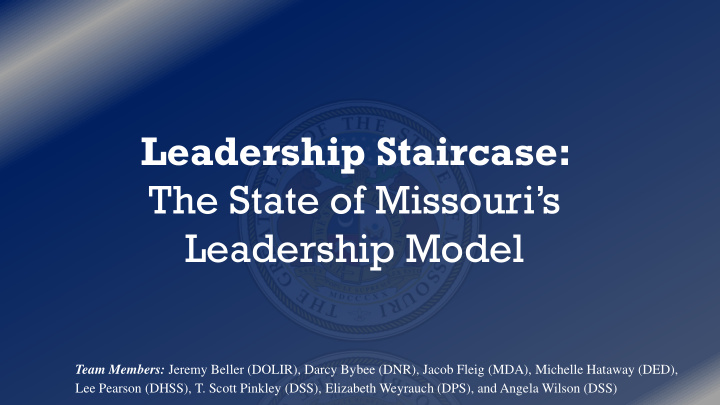



Leadership Staircase: The State of Missouri’s Leadership Model Team Members: Jeremy Beller (DOLIR), Darcy Bybee (DNR), Jacob Fleig (MDA), Michelle Hataway (DED), Lee Pearson (DHSS), T. Scott Pinkley (DSS), Elizabeth Weyrauch (DPS), and Angela Wilson (DSS)
OUR ROADMAP Today Leadership Model Staircase Model Implementation
Where we are today
Inconsistent & Fragmented Approach • 60% of all State employees said they didn’t see any form of leadership in their everyday jobs • Organizations that invest in developing leaders during significant transformations are 2.4 times more likely to hit their performance targets.
COLLEAGUES ARE NOT AWARE OF BASIC ELEMENTS OF THE STATE’S CURRENT APPROACH TO PROFESSIONAL DEVELOPMENT 188 310 67 55 24% 34% 100% 36% 55% Heard of Leadership Competencies 76% 66% 64% 45% Had not heard of Leadership Competencies Total Frontline Supervisor Manager Source: OA coordinated survey (December 2017), N=310
“I AM WILLING TO PUT A GREAT DEAL OF EFFORT BEYOND THAT NORMALLY EXPECTED IN ORDER TO HELP THE ORGANIZATION BE SUCCESSFUL” Source: State of Missouri workforce survey
What is a leadership model?
Successful organizations have one
WHY AND WHY NOW? Why? • The Model will show current and prospective employees that they and their personal, professional development are valued. Why one Model? • Leaders are leaders and people are people—no matter the organization and the individual roles. Why now? • The model will tie together all of the professional development opportunities ongoing across the state, including The Missouri Way, Missouri Leadership Academy, Leadership Library and different cabinet department leadership development programs
WHY THE STATE OF MISSOURI NEEDS ONE A State of Missouri leadership model would create a consistent set of expectations for everyone, and it would improve how we: • Recruit and onboard. • Coach and give feedback. • Celebrate and reward. • Expect our leaders to behave. • Set expectations and hold each other accountable.
Beyond just the Workforce Survey Over 100 people surveyed with representation from all 16 Executive Departments
The Staircase Model
4 THEMES EMERGED Know yourself & Know your job others Keep serving be a great teammate
stairCase approaCh Level 3 Level 2 Achieving impact beyond your direct reports Level 1 Broader impact for yourself and direct reports Learning and doing the basics
Know yourself & others Level 3 Know your stakeholders Level 2 Lead change initiatives Be open to change and maintain Coach others including senior flexibility Level 1 leaders Understand working style of Understand your working style teammates Build on your strengths Be aware of your impact on others Address weaknesses “They knew the strength of their team and distributed work accordingly”
Know your job Level 3 Message strategically Level 2 Build successful partnerships Train and coach others Empower tomorrow’s leaders Level 1 Improve processes Learn your job Plan beyond today’s activities Do your job Hold yourself accountable “Walked the walk that they talked”
be a great teammate Level 3 Create a culture of Do- Learn- Do at scale Level 2 Challenge and motivate the team Build an empowered team Collaborate across Level 1 government Hold everyone accountable Be open and willing to Get everyone on the same page participate Ask for help Contribute to solutions “They instill a sense of ownership within the people and the organization of the thing that needs to be changed.”
Level 3 Keep serving Translate feedback into strategic improvement Level 2 Communicate vision to Recognize customer service stakeholders excellence Level 1 Unwavering dedication to public Assist in complex service service Be happy to help situations Treat all with dignity and respect Anticipate problems Interpret and respond to customer needs “The ability to address each situation uniquely. Take the time to listen to a request/question to be able to provide the best answer (not make a snap decision).”
Level 3 MISSOURI LEADERSHIP STAIRCASE Level 2 Know your stakeholders Lead change initiatives Level 1 Coach others including senior leaders Be open to change and maintain flexibility Understand working style of teammates Be aware of your impact on others Understand your working style Build on your strengths Message strategically Address weaknesses Build successful partnerships Empower tomorrow’s leaders Train and coach others Improve processes Plan beyond today’s activities Learn your job Do your job Hold yourself accountable Create a culture of Do-Learn-Do at scale Challenge and motivate the team Collaborate across government Build an empowered team Hold everyone accountable Get everyone on the same page Be open and willing to participate Ask for help Contribute to solutions Translate feedback into strategic improvement Communicate vision to stakeholders Recognize customer service excellence Unwavering dedication to public service Assist in complex service situations Anticipate problems Be happy to help Treat all with dignity and respect Interpret and respond to customer needs
Implementation
SUGGESTIONS FOR IMPLEMENTATION Integrate into all aspects of Talent Management: • What we look for in recruiting • What we expect of our leaders • How we coach and give feedback • What we celebrate and reward
THANK YOU! QUESTIONS?
Recommend
More recommend